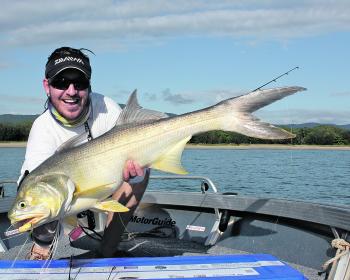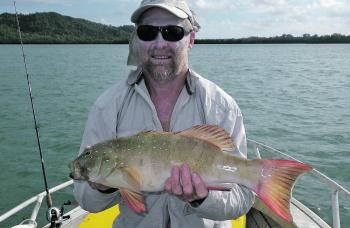The big X-factor for this month will be the sea surface temperature. Normally the water temperature is around the mid-20s by now but it has remained abnormally high and didn’t drop below 30°C until April. Normally this drop occurs at least a month earlier. Extended periods of southeasters will certainly help bring down the water temperature but has the flip-side of keeping anglers shore-bound.
Last year there were still patches of water in the high 20s into mid-May and this year is looking even worse. Once the water temperature drops the fish will start schooling up offshore and the regular cool weather fishing will fire up in the Cairns area. Let’s hope that occurs sooner rather than later.
If the water temperature remains high then the summer approach of continually moving locations out on the reef will be the way to go. If you don’t have a keeper on board in 30mins then move on. Once the waters cool it is better to focus on an area of good country and keep trying nearby spots until you locate the fish biting. Look for fishy country holding bait and give it a bit longer for the fish to come on the bite. If they haven’t come on the bite after an hour or so, then try another spot in the same area rather than moving big distances. Quite often it’s a matter of finding where the fish are schooling up rather than moving all over the place for the odd fish here and there. A lot of time can get eaten up moving locations and while this may be necessary in the warmed months, it’s better to focus on a likely area and wait for the fish to turn it on once the water cools. This approach works best for large mouth nannygai and red emperor in the deep water but can also transfer into the shallow water to chase coral trout and mackerel. In shallow water you can enhance the schooling aspect by using burley.
The deep water rubble patches, gutters and isolated pinnacles will be the most likely places to be holding reds and spots that are also holding good schools of bait are usually big winners. Sharks have remained a constant problem at the reef and they can certainly be a reason to move large distances if they completely dominate a location. When it gets to the point where you can’t get a decent fish past them, then it’s time to move a good distance and try again. They are well known to follow boats over short distances and it can take a fair run at high speed to shake them at times.
Last year the Spanish mackerel showed up in April in spite of the warmer temperatures and once it cooled they were easier to catch. There were reports in late March of big numbers of Spaniards around Snapper Island, that is promising news that the even warmer water hasn’t keep them away this year. Trolling around bait schools, pinnacles, pressure points and current lines is a good way to locate feeding mackerel. Once you have found them, mark the spot on your GPS and keep working the area. Always have a floating pilchard, gar, mullet or wolf herring out the back when bottom fishing, as a couple of good Spaniards can certainly enhance a catch of reef fish. Live baits are even better for targeting Spaniards but do require a bit more time and attention when your main focus is nailing a feed of reef fish.
If we get an extended period of southeasters, it is worth focusing on chasing Spaniards in the first period of calm weather after the blow - especially if it coincides with plenty of run in the tides. The new moon tides over the last weekend in May will be ideal for this. Here’s hoping the seas are smooth.
Last year the inshore reefs, wrecks and islands were holding a lot of cobia and it was hard at times for the mackerel to beat the cobia to your offerings. They certainly give you a much bigger work over than mackerel and some people even prefer them for eating over the silver bullets.
The coastal headlands and reefs will still be holding barra, golden snapper, queenfish and salmon so don’t discount the inshore waters at this time of year. I will often go chasing barra and golden snapper along the headlands whenever the weather turns warm, sunny and still at a time when most people are focused on mackerel fishing. Coral trout can also be caught along the headlands, inshore wrecks and reefs if you put in a bit of effort. Heavy-duty reef rigs won’t do the trick inshore. Fish lighter with live baits and lures and it’s quite surprising what you can turn up.
The net free zone in Cairns has certainly improved the inshore, inlet and estuary fishing so there is always something to chase when the winds are less cooperative. Salmon, both blue and threadfin, are making a real comeback now the nets are out. Once the water temperature drops the fishing will follow but it will spark up again with any patch of warm weather. If the water temperature remains high, as many anglers are expecting, then the estuary fishing should continue to fire. Golden snapper, jacks and barra will remain on the menu in Cairns Inlet and surrounding rivers and creeks well into May if the weather continues its expected pattern.
Don’t forget about the mud crabs! They are usually on the move in May and while they can require a bit of effort at times the reward on the dinner table certainly justifies the effort.
Reads: 4099
Salmon, both blue and threadfin are making a real comeback now the nets are out and David Mayes has been reaping the rewards.

Coral trout, like this one caught by Terry McClelland, can also be caught along the headlands, inshore wrecks and reefs if you put in a bit of effort.




